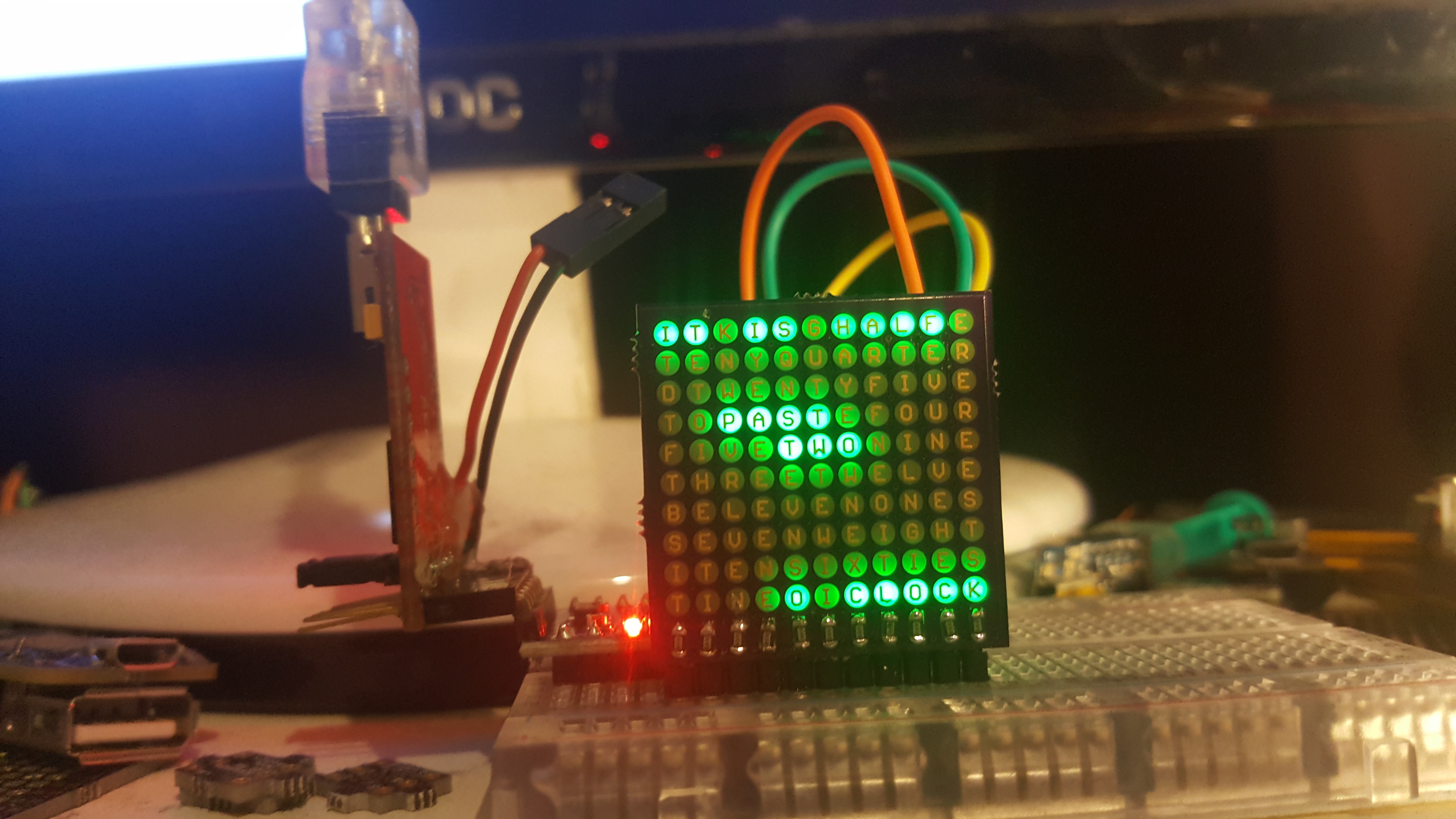-
Version One :)
02/17/2017 at 02:06 • 7 commentsUpdate fun fact: analyzing a charlie plexed matrix for bugs is so much easier when the LEDs are upside down - because of the markings :)
I finally got my LEDs and took the time to hand solder a PCB :) it bleeds a bit in the picture, but in real life it's quite good. The code so far is only a mock up, but there is scanning and matrix stuff involved already.
![]()
#include <avr/pgmspace.h> const int leds[] = {2,3,4,5,6,7,8,9,10,11,12,13}; const int matrix[10][11][2] = { { {1, 0}, {0, 1}, {0, 2}, {0, 3}, {0, 4}, {0, 5}, {0, 6}, {0, 7}, {0, 8}, {0, 9}, {0, 10} }, // 0 { {2, 0}, {2, 1}, {1, 2}, {1, 3}, {1, 4}, {1, 5}, {1, 6}, {1, 7}, {1, 8}, {1, 9}, {1, 10} }, // 1 { {3, 0}, {3, 1}, {3, 2}, {2, 3}, {2, 4}, {2, 5}, {2, 6}, {2, 7}, {2, 8}, {2, 9}, {2, 10} }, // 2 { {4, 0}, {4, 1}, {4, 2}, {4, 3}, {3, 4}, {3, 5}, {3, 6}, {3, 7}, {3, 8}, {3, 9}, {3, 10} }, // 3 { {5, 0}, {5, 1}, {5, 2}, {5, 3}, {5, 4}, {4, 5}, {4, 6}, {4, 7}, {4, 8}, {4, 9}, {4, 10} }, // 4 { {6, 0}, {6, 1}, {6, 2}, {6, 3}, {6, 4}, {6, 5}, {5, 6}, {5, 7}, {5, 8}, {5, 9}, {5, 10} }, // 5 { {7, 0}, {7, 1}, {7, 2}, {7, 3}, {7, 4}, {7, 5}, {7, 6}, {6, 7}, {6, 8}, {6, 9}, {6, 10} }, // 6 { {8, 0}, {8, 1}, {8, 2}, {8, 3}, {8, 4}, {8, 5}, {8, 6}, {8, 7}, {7, 8}, {7, 9}, {7, 10} }, // 7 { {9, 0}, {9, 1}, {9, 2}, {9, 3}, {9, 4}, {9, 5}, {9, 6}, {9, 7}, {9, 8}, {8, 9}, {8, 10} }, // 8 { {10, 0}, {10, 1}, {10, 2}, {10, 3}, {10, 4}, {10, 5}, {10, 6}, {10, 7}, {10, 8}, {10, 9}, {9, 10} } // 9 }; const boolean img [10][11] = { { true, true, false, true, true, false, true, true, true, true, false}, {false, false, false, false, false, false, false, false, false, false, false}, {false, false, false, false, false, false, false, false, false, false, false}, {false, false, true, true, true, true, false, false, false, false, false}, {false, false, false, false, true, true, true, false, false, false, false}, {false, false, false, false, false, false, false, false, false, false, false}, {false, false, false, false, false, false, false, false, false, false, false}, {false, false, false, false, false, false, false, false, false, false, false}, {false, false, false, false, false, false, false, false, false, false, false}, {false, false, false, false, true, false, true, true, true, true, true}, }; void setup() { } void loop() { for (int y=0; y<10; y++) { for (int x=0; x<11; x++) { if (img[y][x]) charlie_matrix (x, y); } } } void charlie_matrix (int x, int y) { int cx = matrix[y][x][0]; int cy = matrix[y][x][1]; digitalWrite(leds[cx], LOW); pinMode(leds[cx], OUTPUT); digitalWrite(leds[cy], HIGH); pinMode(leds[cy], OUTPUT); delayMicroseconds(65); pinMode(leds[cx], INPUT); digitalWrite(leds[cx], LOW); pinMode(leds[cy], INPUT); digitalWrite(leds[cy], LOW); delayMicroseconds(5); } -
some documentation added
01/15/2017 at 13:46 • 0 commentsSince someone on twitter pointed out that the project documentation is an epicfail, I felt compelled to edit the details and add informations on charlieplexing and the general idea. I first was a bit annoyed, but mostly because the entity was right :) I tend to not document my projects very well, mostly because it's easier to write about it afterwards and laziness. Now it feels more complete though.
-
boards are ordered
01/12/2017 at 15:19 • 2 commentsSo for science I've also added the german layout and ordered this one on 0.8mm boards.
PCB word clock
charlie-plexed 11x10 LED matrix, perfect fit for a word clock. Also LEDs soldered on upside down.
 davedarko
davedarko